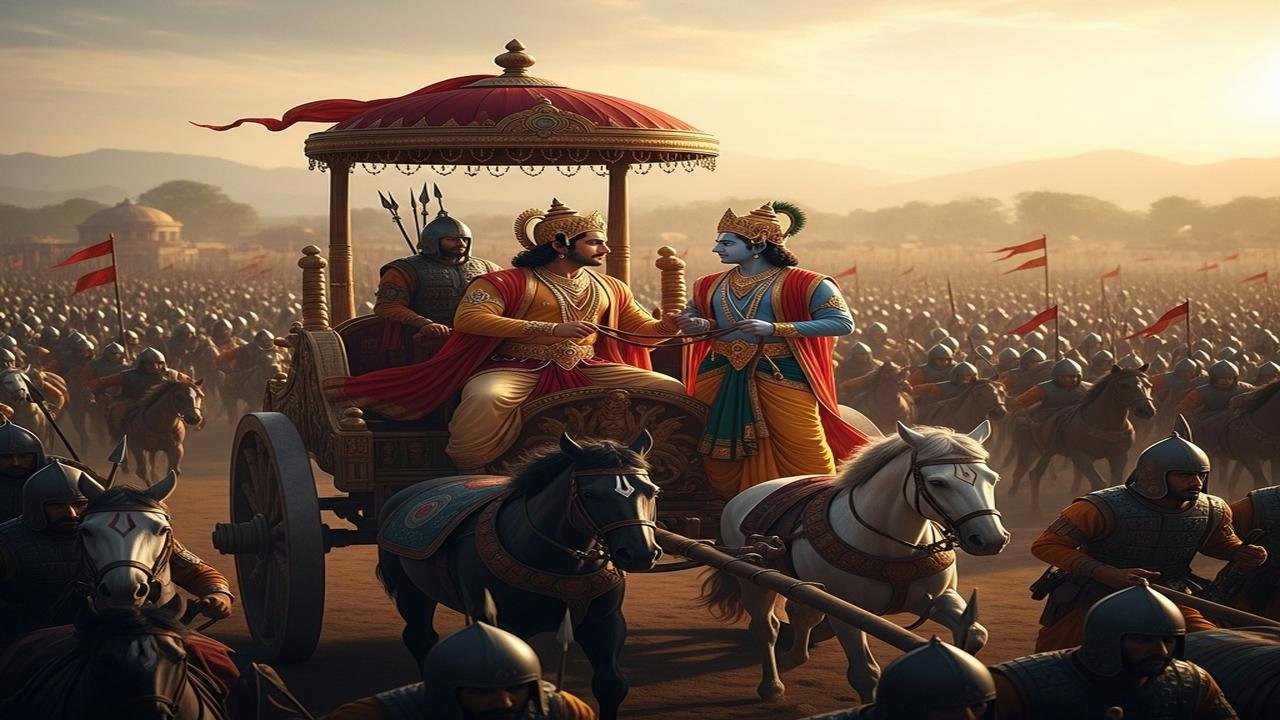Arjuna’s Request at Kurukshetra That Opens the Bhagavad Gita

The scene at the field: what Arjuna asks
In the opening moments of the Bhagavad Gītā episode within the Bhīṣma Parva of the Mahābhārata, the warrior Arjuna asks his charioteer Krishna to place the chariot between the two armies so he can look on those assembled for battle. This simple request—move the chariot to the centre of the battlefield—prepares the narrative frame for Arjuna’s intense moral and spiritual questioning that follows. The episode is often read as the moment when outward action gives way to inward reflection.
Immediate context and practical motive
On the plain of Kurukṣetra, both armies—led by elders, teachers and cousins—face one another. Arjuna’s reasons for asking Krishna to stop in the middle are practical and social as much as psychological:
- He wants to see who is present: veterans like Bhīṣma and Droṇa, friends and relatives (the Mahābhārata repeatedly stresses these family ties).
- He seeks a brief respite to take measurements of the forces and to address individual leaders, a normal pre-battle act.
- It gives him a space to speak privately with Krishna—first to survey the field, and almost immediately after, to voice his doubts and sorrow.
This pause is not merely tactical delay; narratively it becomes a hinge. The battlefield, temporarily arrested, turns into a classroom where moral questions about dharma — ethical duty — and the meaning of action will be examined.
Where this appears in the text
The request occurs at the very opening of the Gītā episode. Many translations and recensions place it just before Arjuna’s famous expressions of grief and confusion. Different editions of the Mahābhārata present scene divisions slightly differently, but all agree on the narrative sequence: placement of the chariot → Arjuna’s survey → his crisis of conscience → Krishna’s teaching.
Layers of symbolism: chariot, charioteer and battlefield
Scholars and spiritual teachers read the action on several symbolic levels.
- Chariot as body/vehicle: Classical Indian thought often uses the chariot as an image for the body or life-situation (compare the Katha Upaniṣad’s chariot allegory). The chariot between armies can signify the individual situated between moral opposites.
- Krishna the charioteer: Krishna’s role is at once literal and symbolic. Literally he drives Arjuna’s vehicle; symbolically he represents guidance—the guru, the inner Self, or the divine leader depending on interpretive stance.
- Battlefield as the world: Kurukṣetra becomes a symbol for the moral arena of life, where competing claims—kinship, duty, reputation—must be weighed.
Different readers emphasise different elements of the metaphor: some stress the psychological drama (inner turmoil), others the metaphysical (Self vs. not-Self), and devotional readers highlight the relationship of lover-disciple or servant-devotee between Arjuna and Krishna.
How traditions and commentators interpret the move
There is a rich diversity of readings across schools and commentators; here are representative lines of interpretation, stated respectfully and briefly.
- Vaiṣṇava/devotional: Krishna is the supreme Lord and the charioteer deliberately takes the place of guide. Arjuna’s request prepares the moment of surrender (śaraṇāgati) and intimate teaching.
- Advaita (e.g., Śaṅkara’s readings): The external drama points to an internal crisis of knowledge; the chariot gesture exposes the hero’s ignorance and primes him for jñāna (knowledge) about the Self.
- Viśiṣṭādvaita/Dvaita: Commentators in these schools read the scene to underline either personal Lord–servant relation (Ramānuja) or the distinct reality of individual souls and the Lord (Mādhva), with Krishna as the living guide.
- Smārta and other readings: Some traditional exegetes treat the moment pragmatically: it is a natural pause to address family ties and duty, underlining ethical complexity rather than allegory alone.
Classical commentators often treat Arjuna’s request as both a physical act and a literary device—an opening that suspends action so the teaching can unfold.
What the pause allows: moral and pedagogical functions
Placing the chariot between armies does several things for the narrative and for readers:
- It creates a neutral vantagepoint from which Arjuna can see both sides and name his dilemmas.
- It gives Krishna an opportunity to teach without immediate pressure from combat, turning a battlefield into a didactic space.
- It dramatizes the tension between social duty and conscience: Arjuna is a kṣatriya expected to fight, yet he is deeply troubled at the idea of killing relatives and teachers.
Living resonances
The image of the chariot and the charioteer remains vivid in Indian religious life. In temple iconography, popular retellings, theatre and Kathā traditions, Krishna as charioteer often stands for divine companionship in action: the Lord who helps the devotee make hard choices. In study and ritual, the moment is cited as an example of how pause, vision and counsel can precede responsible action.
Conclusion: a small gesture with wide implications
Arjuna’s simple request—to have the chariot driven between the two armies—opens the stage for one of Hinduism’s most-discussed spiritual dialogues. It is a practical gesture, a narrative pivot and a rich symbol: a person placed between competing claims, seeking vision and guidance. How one reads that gesture depends on theological and philosophical commitments, but across traditions it is accepted as the crucial instigating moment that turns a warrior’s crisis into a universal conversation about duty, knowledge and devotion.
Note: This account aims to summarise major interpretive lines without taking a sectarian position; readers interested in original-language verses should consult standard editions and commentaries for precise verse numbering and classical commentary.
